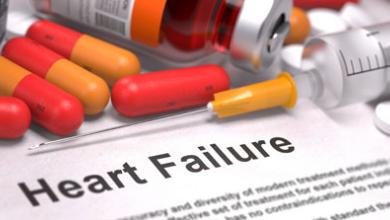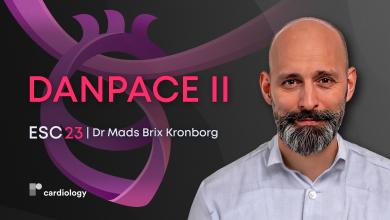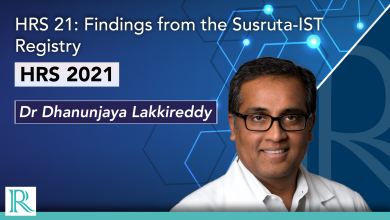Search results
Author(s):
Amarinder Bindra
,
Shelley A Hall
Added:
3 years ago
After a drought in viable new therapies for more than a decade, two new drugs for use in heart failure patients were approved by the US Food and Drug Administration (FDA) in 2015. These drugs represent two new classes of agents in the heart failure space: a combined angiotensin receptor-neprilysin inhibitor (ARNI) (sacubitril/valsartan; brand name Entresto®, Novartis) and a sinoatrial node…
View more
Author(s):
Mads Brix Kronborg
Added:
7 months ago
ESC 2023 — Dr Mads Brix Kronborg (Aarhus University Hospital, DE) joins us to discuss the findings from the DANPACE II Trial (NCT00236158).
DANPACE II (The DANPACE Investigator Group) trial aimed to compare patients who were randomised in a 1:1 ratio to either a base rate of 60 beats per minute and rate-adaptive DDD (DDDR-60 Group) or a base rate of 40bpm and non-rate adaptive DDD (DDD-40…
View more
Author(s):
Rasha Al-Lamee
,
Michael Foley
Added:
1 week ago
ACC.24 — Investigators, Dr Rasha K Al-Lamee and Dr Michael Foley (Imperial College London, UK) joined us to discuss the ORBITA COSMIC trial (NCT04892537).This randomized, double-blinded, placebo-controlled trial investigated the effects of coronary sinus reducer (CSR) as compared to placebo on myocardial perfusion via MRI, exercise duration, and symptoms in patients with refractory angina and…
View more
TCT 23: PICSO-AMI-I
Author(s):
Giovanni Luigi Di Maria
Added:
5 months ago
Video
Author(s):
Dhanunjaya Lakkireddy
Added:
2 years ago
In this interview, Dr Dhanunjaya Lakkireddy (Kansas City Heart Rhythm Institute, Overland Park, KS, US) discusses the outcomes of the multicenter Susruta-IST Registry, which aimed to report upon the outcomes of sinus node sparing surgical thoracoscopic hybrid ablation (SUSRUTA) for inappropriate sinus tachycardia (IST).
Questions:
1. Please summarise the aim, study design and endpoints?
2. What…
View more
Author(s):
Malcolm M Bersohn
Added:
3 years ago
Permanent pacemakers have been used to treat patients with symptomatic bradycardia for 45 years. The earliest pacemakers paced only the ventricle and were used primarily for patients with complete heart block. The need for atrial pacing became apparent as pacing for sinus node dysfunction became more common. Initially, only single-chamber pacing was possible in the atrium, and this was a good…
View more
Author(s):
Malcolm M Bersohn
Added:
3 years ago
Permanent pacemakers have been used to treat patients with symptomatic bradycardia for 45 years. The earliest pacemakers paced only the ventricle and were used primarily for patients with complete heart block. The need for atrial pacing became apparent as pacing for sinus node dysfunction became more common. Initially, only single-chamber pacing was possible in the atrium, and this was a good…
View more
Author(s):
Malcolm M Bersohn
Added:
3 years ago
The usual reason for pacing is to prevent bradycardia, which is most commonly due to sick sinus syndrome or atrioventricular (AV) nodal disease. The need for pacing for either of these indications increases progressively with age. Atrial fibrillation (AF) is the most common serious arrhythmia. The incidence of AF also increases progressively with age, and patients with pacemakers may be even more…
View more
Author(s):
Lori L McMullan
,
Gaston Vergara
,
Nassir F Marrouche
Added:
3 years ago
Atrial fibrillation (AF) and heart failure (HF) are two disease conditions that are intimately intertwined, both pathophysiologically and clinically. Currently, over 2.3 million people in North America and 4.5 million in the EU have AF, making it the most common arrhythmia encountered in clinical practice.1,2 It is expected that by 2050 there will be over 10 million people with AF.3 The estimated…
View more
Author(s):
Henry M Spotnitz
,
T Alexander Quinn
Added:
3 years ago
Surgeons have contributed studies of the pathophysiology and treatment of arrhythmias in experimental animals and patients during thoracotomy. This research has involved epicardial1 and endocardial2 pacemakers and implantable cardioverter–defibrillators (ICDs).3 Surgeons helped to define the mechanisms and ablation methods for supraventricular arrhythmias (including Wolff-Parkinson-White syndrome…
View more














